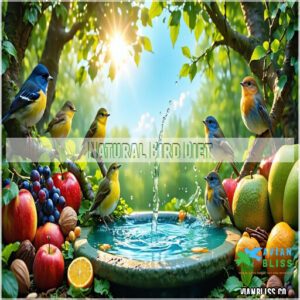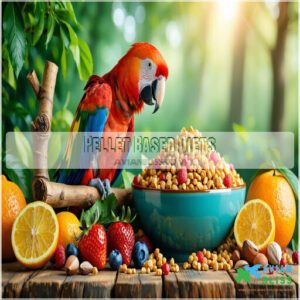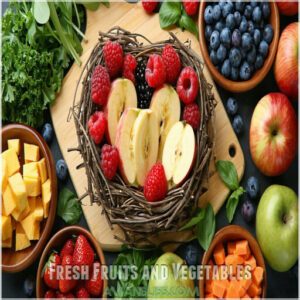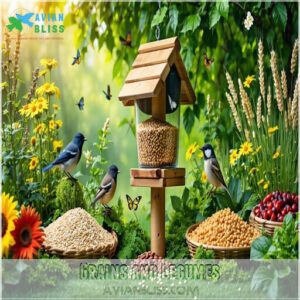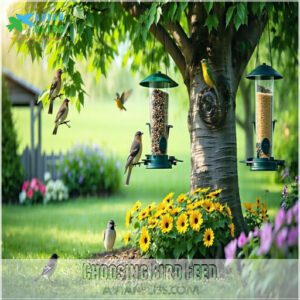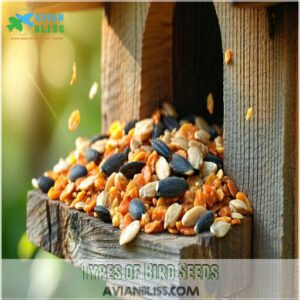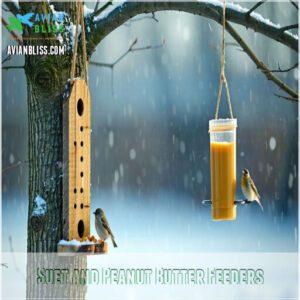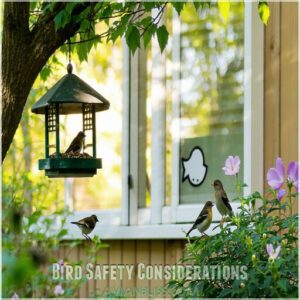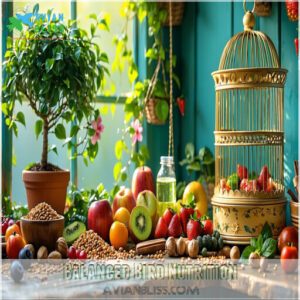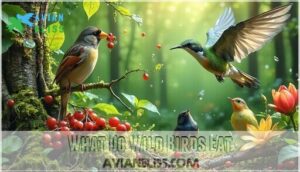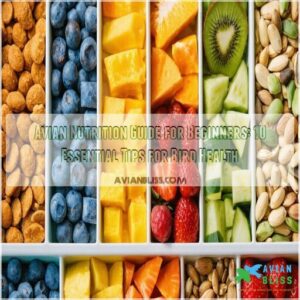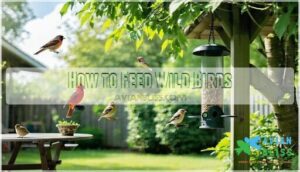This site is supported by our readers. We may earn a commission, at no cost to you, if you purchase through links.
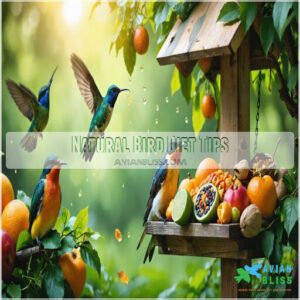 You’ll find that natural bird diet tips aren’t rocket science – they’re just common sense with feathers.
You’ll find that natural bird diet tips aren’t rocket science – they’re just common sense with feathers.
First, know your bird’s specific needs; a hummingbird doesn’t eat like an eagle.
Mix it up with pellets, fresh fruits, veggies, and appropriate seeds – variety isn’t just the spice of life, it’s the main course for healthy birds.
Clean those feeders weekly (nobody likes a moldy restaurant), and place them in predator-safe zones.
Think of yourself as your bird’s personal nutritionist, balancing proteins, fats, and vitamins. And remember, the right diet doesn’t just keep them flying – it helps them truly soar through life, with a healthy balance and a variety of foods.
Table Of Contents
- Key Takeaways
- Natural Bird Diet
- Bird Food Options
- Feeding Wild Birds
- Bird Safety Considerations
- Balanced Bird Nutrition
- Frequently Asked Questions (FAQs)
- What is the best natural bird feed?
- What is the 5 7 9 rule for bird feeders?
- What is the healthiest food for birds?
- How do you make homemade bird feed?
- How to feed seasonal wild berries?
- When to change nestling feeding patterns?
- Sprouting seeds benefit for birds?
- Night-feeding birds nutritional requirements?
- Impact of seasonal migration on diet?
- Conclusion
Key Takeaways
- You’ll need to understand your bird’s specific dietary needs since different species require different nutrients – what works for a hummingbird won’t work for an eagle.
- You should provide a diverse diet that includes pellets as the foundation, fresh fruits and vegetables for essential nutrients, and a small portion of seeds and nuts as treats.
- You’ll want to place feeders strategically using the 5-7-9 rule: 5 feet from cover, 7 feet off the ground, and 9 feet from buildings to protect birds from predators while feeding.
- You must clean feeders weekly with a 9:1 water-bleach solution and store seeds in airtight containers to prevent spoilage and maintain bird health.
Natural Bird Diet
You’re about to learn how to create a natural bird diet that’s perfect for your feathered friends, with tips on what to feed them and how to keep them healthy.
By following these simple tips, you’ll be well on your way to providing a balanced and nutritious diet that’ll make your birds happy and thriving!
Species Specific Dietary Needs
You’ll find that bird size, dietary restrictions, and nutrient requirements vary greatly among species, so understanding your bird’s speciesspecific diet is essential for proper bird nutrition and a native bird diet that meets their avian diet needs.
Birds have unique dietary adaptation needs that must be considered when determining their nutritional requirements.
Importance of Variety in Diet
You need a varied diet for your bird, with diet diversity and food rotation.
Consider:
- Meal variety
- Foraging options
- Nutrient balance to keep them healthy and happy, ensuring a natural bird diet with dietary diversity and essential nutrient sources.
This will help ensure your bird has a balanced diet.
Essential Nutrients for Birds
You’re learning about birds’ diets, with protein sources, like eggs and beans, being essential.
Vitamin and mineral supplements also support their health, ensuring balanced diets and preventing nutrient deficiencies, with proteins, fats, vitamins, and minerals being essential nutrients for bird.
A nutritionally balanced avian base diet is essential for a bird’s health and lifespan.
Bird Food Options
You’re looking for the best bird food options, and you’ve come to the right place.
Now, you can explore pellet-based diets, fresh fruits and vegetables, and grains and legumes to find the perfect mix for your feathered friends.
Pellet Based Diets
You’re considering a pellet-based diet for your bird.
- Pellet nutrition provides balanced diets
- Seed supplements support nutrient needs
- Feeding guidelines guarantee a balanced bird diet, covering parrot diet and avian nutrition, with pellet-based diet as the foundation.
Understanding Pellet Bird Food is essential for ideal nutrition and a balanced bird diet.
Fresh Fruits and Vegetables
You’re selecting fruits and veggies for your feathered friends.
Choose birdsafe fruits like apples, bananas, and berries.
Consider bird safe fruits products for your birds.
Prep fresh vegetables, considering nutrient content and bird favorites, for a healthy veggie chop, and follow feeding tips to achieve a balanced diet with the right fruit selection.
Grains and Legumes
You’re exploring grains and legumes for birds, a great choice!
Quinoa benefits and legume nutrition offer a boost.
Opt for bird-safe grains like oats, barley, and brown rice, and try bean recipes for a tasty twist, adding variety to their seed selection and supplemental bird food.
Feeding Wild Birds
You’re about to learn how to feed wild birds, and it’s easier than you think, just remember to choose the right feed.
By selecting the perfect bird feed, like black-oil sunflower seeds or suet, you’ll be attracting all sorts of birds to your yard in no time.
Choosing Bird Feed
You’re choosing bird feed, an important step in natural bird feeding. Consider seed selection, feed types, and bird preferences to achieve nutrient balance.
For ideal nutrition, explore best bird feed options. Think about feeder placement too, it matters.
Get the best bird food, a great bird seed mix, and supplemental bird food with this bird feeding guide.
Types of Bird Seeds
You’ll find Sunflower Seeds, Safflower Seeds, and Nyjer Seeds are popular among birds.
Millet Seeds and black oil sunflower seeds are also favorites.
Offer a bird seed mix with these options for a balanced seed diet, including birdsafe seeds like nyjer seeds for a healthy treat.
Suet and Peanut Butter Feeders
You’re now considering suet and peanut butter feeders, a great way to attract birds, especially in winter.
Suet feeders offer high-energy suet, while peanut butter feeders provide a tasty, nutritious treat, complementing nyjer seeds and black oil sunflower seeds, making your yard a bird attractant hotspot.
By using high-quality suet feeder options, you can effectively support the local bird population and enhance your backyard bird watching experience.
Bird Safety Considerations
You’ll want to keep your feathered friends safe while they enjoy their meals, just like you wouldn’t want uninvited dinner guests crashing your party.
While birds bring joy to your backyard buffet, it’s important to protect them from window strikes and sneaky predators who might try to turn your feeding station into their own drive-through restaurant, to keep them safe.
Window Collisions and Solutions
Birds face a tough challenge with window collisions, but you’ve got several effective solutions at your fingertips.
Window films and decals can transform dangerous glass surfaces into bird-safe zones.
Here’s what works best:
- External screens provide maximum protection while maintaining visibility
- Strategic placement of bird window decals breaks up reflections
- Glass coatings specifically designed for bird safety
- Urban planning initiatives promoting bird-friendly architecture
- DIY solutions like hanging streamers or applying window films
Protecting Birds From Predators
While window safety keeps birds from harmful collisions, predators pose another threat to your feathered friends.
You’ll want to install predator guards around feeders and create cozy bird shelters using dense shrubs or nest boxes.
Smart feeder security includes hawk deterrents like reflective tape or wind chimes.
A mix of natural cover and strategic placement helps your backyard birds dodge those sneaky cats and crafty hawks.
Feeder Placement and Maintenance
A well-placed bird feeding station can make all the difference in attracting feathered friends while keeping them safe.
Position feeders 3-30 feet from windows to prevent collisions, and install predator guards for extra protection.
Consider various bird feeder setup options for different species.
Keep your feeder height between 5-6 feet for most songbirds, and don’t forget weekly cleaning with a 9:1 water-bleach solution, and store seeds in airtight containers to prevent spoilage.
Balanced Bird Nutrition
You’ll find that keeping your feathered friend healthy is a lot like making a perfect sandwich – it’s all about having the right ingredients in the right amounts.
Your bird’s daily menu should include a mix of pellets as the foundation, fresh fruits and veggies for essential nutrients, and just a sprinkle of seeds and nuts for treats, just like adding those tasty little extras that make your sandwich special, with the right balance being key to a healthy bird.
Importance of Pellets in Diet
Anyone can see why pellets are the rock stars of bird nutrition – they’re basically a complete meal in every bite.
You’ll find these seed alternatives packed with essential nutrients that your feathered friend needs.
Think of pellets as your bird’s daily multivitamin, offering balanced nutrition without the mess of scattered seeds.
The bird food pyramid shows pellets as the foundation, and for good reason – they’re nutritionally complete!
Fresh Foods for Balanced Nutrition
Most birds thrive when you regularly incorporate fresh foods into their diet.
Mix colorful vegetables (like kale, carrots, and broccoli) to create a nutrient-packed "bird chop."
This food variety provides your feathered friend with essential vitamins and minerals.
Try offering these healthy treats in the morning when they’re hungriest—your bird might just "go bananas" for this balanced approach to eating fresh foods with a variety of colorful vegetables.
Avoiding Harmful Foods and Substances
Let’s spread our wings and talk about keeping your feathered friend safe from toxic foods and hazardous substances.
Just like you’d childproof a home, birdproofing your kitchen is essential to prevent avian poisoning.
Providing a balanced diet with healthy bird options is vital for their well-being.
- Avocados are a big no-no – even a small amount of persin can be fatal
- Keep chocolate and caffeine strictly for humans
- Remove all seeds from apples and stone fruits to avoid cyanide risks
- Skip the aromatics – onions and garlic are toxic troublemakers
- Watch out for artificial sweeteners like xylitol
Frequently Asked Questions (FAQs)
What is the best natural bird feed?
A bird in hand needs nature’s best!
You’ll want to offer black-oil sunflower seeds, nyjer seeds for finches, and fresh fruits like berries.
Don’t forget protein-rich mealworms – they’re a natural favorite!
What is the 5 7 9 rule for bird feeders?
You’ll want to place feeders 5 feet from cover, 7 feet off the ground, and 9 feet from buildings. This setup creates a sweet spot that keeps birds safe while they’re dining.
What is the healthiest food for birds?
You’ll want to provide a mix of pellets, fresh vegetables, and fruits for peak bird health.
Dark leafy greens, berries, and sprouted seeds pack powerful nutrients, while pellets offer balanced nutrition every day.
How do you make homemade bird feed?
You’ll be cooking up a storm when you mix chopped fresh vegetables, cooked grains, and seeds together.
Add fruits like berries and apples, then portion into daily servings and freeze for convenience.
How to feed seasonal wild berries?
You’ll have the most berry-licious success by placing washed wild berries on platform feeders or mixing them with seed.
Small berries should be crushed slightly, while larger ones can be halved for easier pecking.
When to change nestling feeding patterns?
Like orchestra conductors, you’ll notice when to change feeding patterns as your nestlings reach day 8-13, when wing-flapping increases and feeding rates peak before gradually tapering off toward fledging time.
Sprouting seeds benefit for birds?
Sprouted seeds pack a nutritional punch for your feathered friends.
You’ll boost their health with these mini powerhouses of enzymes, vitamins, and minerals.
They’re nature’s multivitamin—easier to digest than dry seeds and absolutely irresistible to most birds, making them a great way to provide a nutritional boost.
Night-feeding birds nutritional requirements?
Nocturnal birds like owls need a protein-rich diet. You’ll want to provide small mammals, insects, and occasional reptiles. Their midnight munchies are quite meaty—they’re nature’s rodent control specialists!
Impact of seasonal migration on diet?
You’d think birds just wing it during migration, but they’re nature’s strategic planners.
They’ll boost their energy with rich foods before flying, and cleverly adapt their diet to available resources along their routes.
Conclusion
Taking flight with natural bird diet tips isn’t just about filling feeders – it’s about nurturing your feathered friends‘ well-being.
You’ve got the knowledge to create a balanced buffet that’ll keep your birds chirping with joy.
Remember, whether you’re feeding backyard visitors or pet companions, variety is key.
Keep those feeders clean, safe, and stocked with appropriate foods.
With these tips in your wings, you’re ready to help your birds thrive naturally. Happy feeding!

